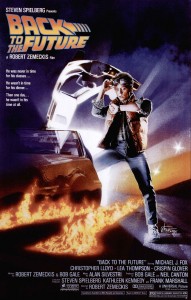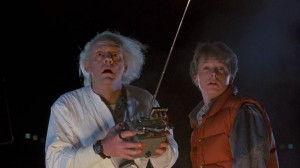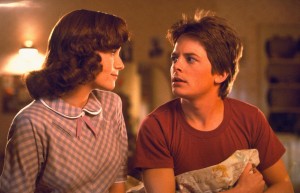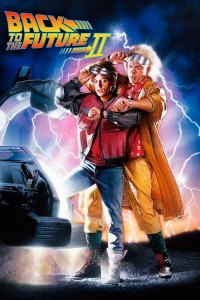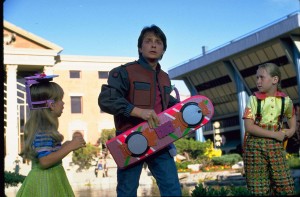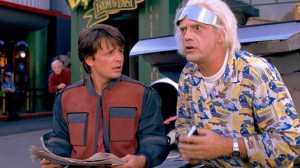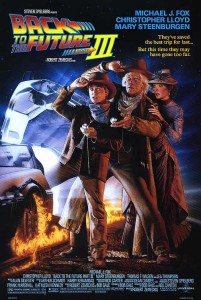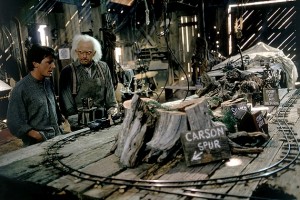This week is a strange one in Hollywood lore: Wednesday, October 21, 2015, is the date in the future that Doc Brown takes Marty and Jennifer to in Back To The Future Part II. Director Robert Zemeckis chose the date randomly, a little more than 30 years from when the film was released on the July 4th weekend in 1985.
Here’s a brief look back at the three movies, with some spoiler-heavy commentary:
Back To The Future (1985)
Directed by Robert Zemeckis | Written by Zemeckis and Bob Gale | 116 min
Last week I reviewed The Martian, calling it a bit of Hollywood hokum, a popcorn movie. Though I was throwing a little light derision with the comment, Back To The Future is a superior bit of Hollywood hokum, with no criticism intended.
Back To The Future is a wildly entertaining popcorn movie, and one of Hollywood’s best time travel movies. It announced Zemeckis as one of Spielberg’s most talented mentees. His movie stands perfectly well on its own, but of course they couldn’t let it well enough alone, shooting two sequels back-to-back.
In the first, best one, Marty McFly (Canadian Michael J. Fox playing the quintessential loveable American teen) goes back in time from 1985 to 1955 in a DeLorean time machine, customized by his buddy Doc Brown (Christopher Lloyd). How these two ever became chummy is never explained, but the 1985 depicted here (largely shot on the HD-really-makes-it-look-like-a-backlot backlot at Universal Pictures) is a suburban paradise, complete with appallingly obvious product placement and Huey Lewis and the News.
But the script is absolutely jammed with ingenuity. Every detail of the first act is a seed that pays off later in the picture, with a stellar twist that Marty’s mother (the wonderful Lea Thompson) turns out to be much less conservative as a teen than she claimed, making for some hilarious Oedipal discomfort, and Crispin Glover perfectly pitches his patented peculiarities as Marty’s clueless father.
MVP goes to Christopher Lloyd—his Doc Brown manages a genuine balance of wacky and brilliant to the point where today he’s still the cultural icon of a mad scientist, as recognizable as the bolts in Frankenstein’s monster’s neck. (Try to imagine Rick And Morty without him.)
But, unlike Mary Shelley’s cautionary tale of playing god with tech, this is one where science is shown to improve people’s lives, provided you’re careful with it. Maybe that’s what’s best about the movie—it runs with a thrilling sense of optimism about what’s to come, that this world is the best of all possible ones (even if it got this way by going back and straightening a few things out).
That said, the conclusion, however clever it is, manages to be one of the 1980s most earnest manifestations of materialist wish-fulfillment—one major change back in 1955, and not only do Marty’s parents have a better marriage and better taste, everyone (excepting bully Biff, played by Thomas F. Wilson) is conspicuously wealthier. It’s to the credit of the second film that it makes Marty a victim of his own greed.
Big kudos also to Alan Silvestri for creating a score that, while indebted to the John Williams music from earlier Amblin movies, still manages to be totally distinct and anthemic.
Back To The Future Part II (1989)
Directed by Robert Zemeckis | Written by Bob Gale and Zemeckis | 108 min
I hadn’t seen BTTF II since it was first in theatres in November 1989, and I recall not liking it much back then. It felt like a cynical cash-in, an argument you could make against any sequel, but this one felt especially calculated.
That first impression felt right on the money as I sat through the first act a second time, which picks up right in the last minute of the first movie, except with Marty’s girlfriend Jennifer transmogrified from Claudia Wells into Elizabeth Shue.
As mentioned, Doc Brown brings Marty and Jen to October 2015 in the time-travelling DeLorean, now a flying machine. But the future imagined is a garish, OTT version of the 1980s, with much of the FX sub-Ghostbusters standard (Zemeckis would get better with this kind of thing by Forrest Gump and this month’s The Walk) and maybe the worst old-age make-up in Hollywood history.
(Credit where it’s due: The prediction of the Chicago Cubs sweeping the 2015 World Series isn’t entirely outside of possibility at the time of this writing.)
Worse, the set-up is a schlocky rewrite of the first movie, shoe-horning a single character flaw into Marty’s character (totally absent in the first film) and telling of a single event that changes his entire future. Sound familiar? It’s also a mistake to let Thomas F. Wilson’s Biff the Older, Younger, and Junior, carry so much of the picture. I know this is ostensibly a comedy, but the performance is such a cartoon in every version you expect smoke to issue from his ears and horns from his brow.
Things improve when Doc, Jennifer, and Marty return to 1985 to find it changed, a Pottersville version of Hill Valley, a reality where Biff used the time machine to go back and make himself wealthy. (It’s like small-town America under the thumb of Donald Trump.) The Capra-esque vision is surprisingly bleak, and Marty’s dawning realization of his culpability adds a welcome bit of depth to the material, though the question of why the 2015 version of Hill Valley didn’t immediately change to Tannertown when Biff returned from the past in the DeLorean isn’t explained. Is it because Biff creates an entirely separate timeline when he goes back to 1955? I need to consult my Rules of Time Travel guide.
(Speaking of time travel movies, feel free to check out my podcast—with living encyclopedia of film Stephen Cooke—on the subject, which you can download here at the bottom of this list.)
The third act return of our heroes to the fateful night in 1955 is clever enough, providing an alternate series events around those in the first movie, though there are moments where it feels like the only point of the thing is to show Fox (unconvincingly) twice in one scene. There are also moments when that almanac magically gets its cover back after Biff tears it off to cover his girlie mag. You’d think the people plotting a time travel movie with this many jumps through time could get right that bit of continuity.
Ending the movie on a cliffhanger—the one from the first movie felt rhetorical, while this is just blatant, with a tagged-on trailer for the third movie (released six months later in May, 1990) brings back that cash-grab feeling, leaving a bit of a sour taste that even a Joe Flaherty cameo can’t wash away.
Back To The Future Part III (1990)
Directed by Robert Zemeckis | Written by Bob Gale and Zemeckis | 118 min






